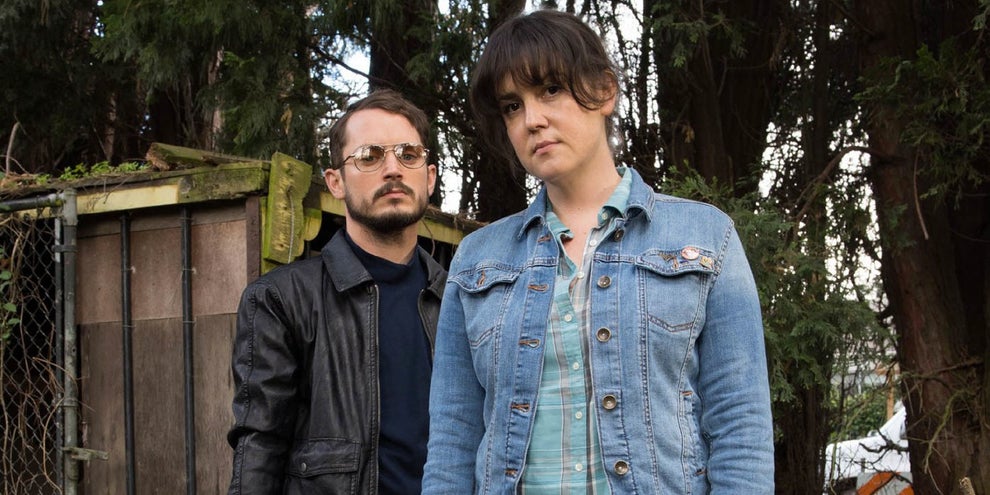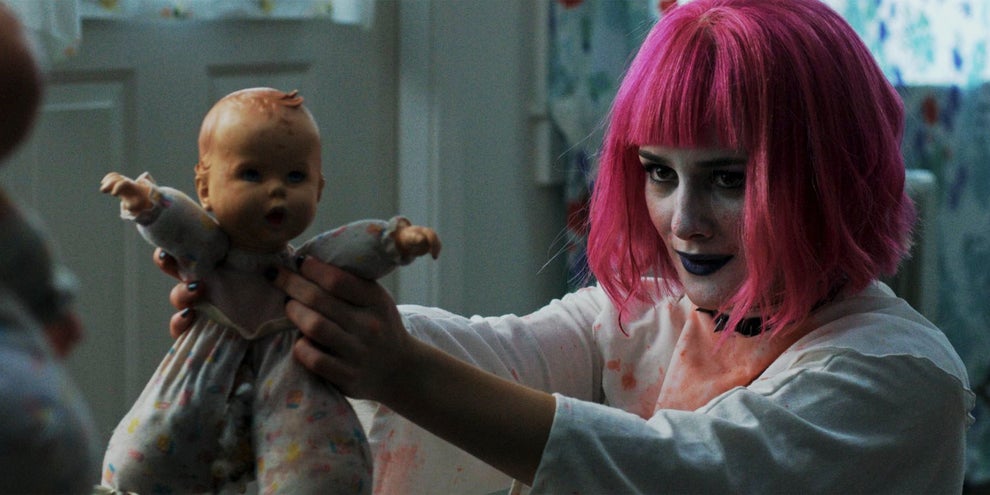
Some people use giant vacuum bags to store sweaters when they’re out of season. Those are what the killer in Creepy uses to store dead bodies. The first time we see evidence of this gruesome tactic, a cop stumbles onto one of these shrink-wrapped corpses tucked away in a closet, the shriveled remains sealed up in plastic like a cutlet. The second time, we see the murderer in action, and the body is a lot fresher. The combination of the mundane and the nightmarish is what Creepy thrives on; it’s a film that’s not quite mystery and not quite horror, but something unsettling in its own right.
Creepy is one of two films director Kiyoshi Kurosawa released last year (it’s set in suburban Japan while the other, Daguerrotype, takes place in France). He’s best known as part of the wave of J-horror directors whose work was imported and remade in the late ’90s and early ’00s. There’s nothing overtly supernatural about Creepy’s narrative: a retired detective (Hidetoshi Nishijima) moves with his wife (Yuko Takeuchi) to the suburbs, only to get caught up in a cold case and trying to figure out the deal with a strange neighbor. But the dread that builds up, effectively and terribly, over its runtime certainly owes something to the aura of casual evil surrounding its antagonist. Something’s obviously off about him from the start, and what’s just as scary as his gruesome crimes is how easily he’s able to pull others into his dark world — the characters so disaffected that they’re vulnerable to his warped energy. His is a grotesque parody of domesticity that people surrender themselves to, out of their own unhappiness and isolation.
How to see it: Creepy is now out on DVD and is available for digital purchase and rental.
2. Elijah Wood agrees to be backup, no questions asked, in I Don’t Feel at Home in This World Anymore.
As Tony, Elijah Wood sports a rattail. He also blasts metal, lifts weights in his backyard, and is unexpectedly active in his Christian faith. But none of these details is as telling as the moment that his neighbor Ruth (Melanie Lynskey), who’s spoken to him twice in her life, shows up as his door and tells him she needs backup. “Okay,” he says, no questions asked, like he’s been waiting his entire life for a near-stranger to come by and request his help. Which…he probably has. Tony is a loner who keeps throwing nunchaku and stars around the house, and who has an earnest but unearned confidence is his own physical formidability.
Tony is just longing for a chance to right a wrong in a world that feels filled with them, which makes him the perfect sidekick for Ruth, a lonesome woman who reaches her breaking point when her house is broken into and robbed. Part Napoleon Dynamite, part Blue Ruin (which starred writer/director Macon Blair), I Don’t Feel At Home In This World Anymore is a funny, violent, amateur revenge thriller that deploys Lynskey as an unlikely but totally wonderful action hero, and that won a Grand Jury prize at Sundance earlier this year with its brutal charms.
How to see it: I Don’t Feel at Home in This World Anymore is streaming on Netflix.
There’s an early scene in Ceyda Torun’s documentary Kedi in which an orange tabby struts along the sidewalks of Istanbul like they belong to her, and all the people around are just convenient dispensers of food. The camera nimbly tracks the cat on her routine of scrounging food, begging at the feet of indulgent patrons of an outdoor café and checking out the contents of a discarded bag before walking, easy as you please, into a store to take an offering from the cashier. The elegance of the way she trots through the streets to take the cake she’s been given to her bundle of waiting kittens is a total delight.
Kedi documents some of Istanbul’s thousands of strays, as well as the people who feed, care, and watch out for them. For centuries, cats have been a part of Istanbul’s cityscape, belonging to no one but cared for by everyone who puts out water or spares a nibble. Throughout Kedi, a film as soothing as a warm bath, different interviewees talk about their histories with different cats, about cats healing them or saving them, about cats as feminine figures or embodiments of freedom. It’s a life with more dangers, being out on the streets, but sunny as it may be, the portrait Kedi offers is mesmerizing — that of a city that belongs to its animal inhabitants as much as it does its human ones.
How to see it: Kedi is now playing in limited release.
4. A woman revisits her goth roots for the sake of family in Little Sister.
Forager Films
When Little Sister’s protagonist Colleen (Addison Timlin) dyes her hair pink, slaps on some black lipstick, and performs a jello-as-baby-gore lip sync to Gwar, it has to be the most poignant return to goth-dom ever committed to screen. Colleen, who moved away from her childhood home of Asheville, North Carolina, years ago, is now far from the pale foundation–loving teen she was. She’s become a nun in training, preparing to take her vows and ministering to the poor in Brooklyn. But for her brother, Jacob (Keith Poulson), a recently returned war vet dealing with a facial disfigurement from an encounter with a land mine, she’s willing to revisit the past. Maybe even a bit eager to — once a goth girl, forever a goth girl, at least at heart.
Zach Clark’s movie follows a standard indie template — a character heads home and has to reckon with estranged family or a repressive area. But in a twist to the usual formula, Colleen’s parents’ (Peter Hedges and, in a nice bit of meta-casting, Ally Sheedy) failure to understand their daughter comes not from the fact that they’re conservative. Instead, the parents are pot-smoking progressives glued to coverage of the 2008 election unfolding in the background. When Colleen’s mother jokes she expected her daughter would grow up to be a “lesbian satanist,” Colleen miserably replies, “Sometimes I think you’re sad I’m not.” The way her parents stare when she prays before a meal is a reminder that being truly accepting means coming to terms with things you’re not comfortable with — be that a heavily eyelinered goth phase, or the choice to devote one’s life to God.
How to see it: Little Sister is available on Blu-ray/DVD and for digital purchase and rental. It’s also streaming on Netflix.
5. Everyone bags on Life Is Beautiful in The Last Laugh.
Ferne Pearlstein / The Film Collaborative
The one thing almost everyone in The Last Laugh can agree on is that Roberto Benigni’s sickly sweet Life Is Beautiful bites. “The worst movie ever made!” yells the god Mel Brooks. “To make a comedy about a concentration camp and avoid what really went on there, it’s a great trick, but it’s absolutely meaningless.” “Seriously, the blurb should be, ‘He puts the ‘hah’ in ‘Holocaust’!” adds Gilbert Gottfried. The interviewee who does go to the mat for the movie, Abraham Foxman, isn’t from the world of comedy but from the Anti-Defamation League — which speaks to how little consensus Ferne Pearlstein’s documentary features in tackling the topic of taboo laughs, specifically about the Holocaust.
During what’s become a huge moment for hate speech getting passed off as humor, The Last Laugh is a straightforward talking-heads-and-archival-footage doc that’s acquired a depressing timeliness in tackling who gets to make jokes about what and the concept of “punching up.” But it’s also refreshingly nuanced in dealing with how little control people have over what others are laughing at, particularly in a bit as boundary-pushing as, say, the “In My Country There Is Problem” singalong in Sacha Baron Cohen’s Borat. Sarah Silverman, another of the interviewed comedians, cites a friend who used to call these “mouthful-of-blood laughs,” a bitter reminder that the more cutting the joke, the more it is at the mercy of its audience to understand the target.
How to see it: The Last Laugh is now playing in limited release.
Foreign animated movies aren’t famous for their post-credits scenes, so it’s worth pointing out that there is one at the end of My Life as a Zucchini, and that it offers another level of commentary to the main story. It’s presented as an audition tape, as if the stop-motion puppet serving as the main character were actually a child actor who goes on to discuss the relatability of the story and then ask if he could change the protagonist’s name, should he be chosen for the film.
The answer must be no, since “Zucchini” retains his oddball nickname throughout the film, a French/Swiss stop-motion affair that was up for the Best Animated Feature at the Oscars this year. (It lost to Zootopia.) But that post-credits sequence provides a touch of softness and distance to a film that deftly uses bright colors and character designs to tell a story that goes to some dark places. Directed by Claude Barras and adapted from a novel by Gilles Paris, My Life as a Zucchini follows the title character, a 9-year-old boy, after an accident leads to the death of his alcoholic mother and lands him in a group home. The kids he ultimately befriends there have been neglected, abused, or separated from their parents by deportation. It’s sad material that the movie doesn’t soft-pedal, but rather, treats from a child’s-eye view that makes the whole affair both more bearable and more tragic.
How to see it: My Life as a Zucchini is now playing in limited release.




